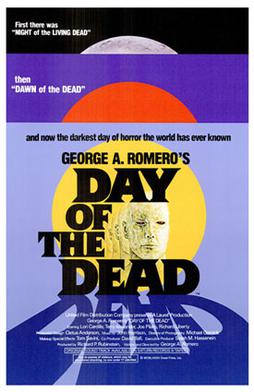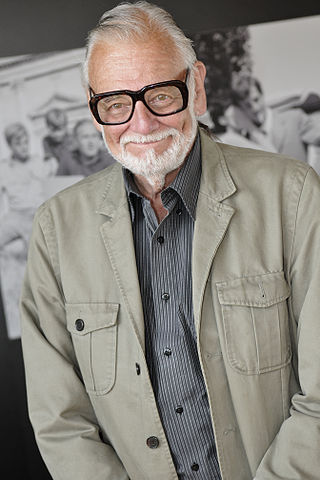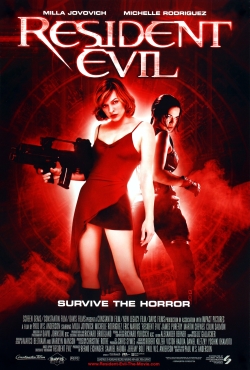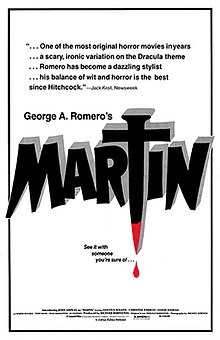
Buffy the Vampire Slayer is a 1992 American comedy horror film directed by Fran Rubel Kuzui and starring Kristy Swanson, Donald Sutherland, Paul Reubens, Rutger Hauer, Luke Perry, Hilary Swank, and David Arquette. It follows a Valley Girl cheerleader named Buffy who learns that it is her fate to hunt vampires. It was a moderate success at the box office, but received mixed reception from critics. The film took a different direction from that which its writer, Joss Whedon, intended. Five years later, he created the darker, and critically acclaimed, television series of the same name.

Night of the Living Dead is a 1968 American independent horror film directed, photographed, and edited by George A. Romero, with a screenplay by John Russo and Romero, and starring Duane Jones and Judith O'Dea. The story follows seven people who are trapped in a rural farmhouse in western Pennsylvania, which is under assault by an enlarging group of flesh-eating, undead ghouls.

Day of the Dead is a 1985 American post-apocalyptic zombie horror film written and directed by George A. Romero, and produced by Richard P. Rubinstein. The third film in Romero's Night of the Living Dead series, it stars Lori Cardille, Terry Alexander, Joseph Pilato, Jarlath Conroy and Richard Liberty as members of a group of survivors of a zombie apocalypse sheltering in an underground bunker in Florida, where they must determine the outcome of humanity's conflict with the undead horde. Romero described the film as a "tragedy about how a lack of human communication causes chaos and collapse even in this small little pie slice of society".

The Great Santini is a 1979 American drama film written and directed by Lewis John Carlino. It is based on the 1976 novel of the same name by Pat Conroy. The film stars Robert Duvall, Blythe Danner, and Michael O'Keefe.

Ragtime is a 1981 American drama film directed by Miloš Forman, based on the 1975 historical novel Ragtime by E.L. Doctorow. The film is set in and around turn-of-the-century New York City, New Rochelle, and Atlantic City, and includes fictionalized references to actual people and events of the time. The film stars James Cagney, Mary Steenburgen, Howard Rollins, Brad Dourif, James Olson and Elizabeth McGovern, features the final film appearances of Cagney and Pat O'Brien, and features early appearances in small parts by Jeff Daniels, Fran Drescher, Samuel L. Jackson, Ethan Phillips and John Ratzenberger.

George Andrew Romero was an American-Canadian filmmaker, writer, editor and actor. His Night of the Living Dead series of films about an imagined zombie apocalypse began with the 1968 film of the same name, and is often considered a major contributor to the image of the zombie in modern culture. Other films in the series include Dawn of the Dead (1978) and Day of the Dead (1985). Aside from this series, his works include The Crazies (1973), Martin (1977), Knightriders (1981), Creepshow (1982), Monkey Shines (1988), The Dark Half (1993), and Bruiser (2000). He also created and executive-produced the television series Tales from the Darkside, from 1983 to 1988.

Hollywood Ending is a 2002 American comedy film written and directed by Woody Allen, who also plays the principal character. It tells the story of a once-famous film director who suffers hysterical blindness due to the intense pressure of directing.

Survival of the Dead is a 2009 horror film written and directed by George A. Romero and starring Alan van Sprang, Kenneth Welsh and Kathleen Munroe. It is the sixth entry in Romero's Night of the Living Dead series. The story follows a group of AWOL National Guardsmen who briefly appeared in Diary of the Dead.

Land of the Dead is a 2005 post-apocalyptic horror film written and directed by George A. Romero; the fourth of Romero's six Living Dead movies, it is preceded by Night of the Living Dead, Dawn of the Dead and Day of the Dead, and succeeded by Diary of the Dead and Survival of the Dead. It was released in 2005, with a budget of $15–19 million, the highest in Romero's Dead series, and has grossed $46 million.

Resident Evil is a 2002 action horror film written and directed by Paul W. S. Anderson. The film stars Milla Jovovich, Michelle Rodriguez, Eric Mabius, James Purefoy, Martin Crewes, and Colin Salmon. It is the first installment in the Resident Evil film series, which is loosely based on the video game series of the same name. Borrowing elements from the video games Resident Evil and Resident Evil 2, the film follows amnesiac heroine Alice and a band of Umbrella Corporation commandos as they attempt to contain the outbreak of the T-virus at a secret underground facility.

Knightriders is a 1981 American drama film written and directed by George A. Romero and starring Ed Harris, Gary Lahti, Tom Savini, Amy Ingersoll, Patricia Tallman, and Christine Forrest. It was filmed entirely on location in the Pittsburgh metro area, including Fawn Township and Natrona during the summer of 1980.

Innocent Blood is a 1992 American black comedy horror film directed by John Landis and written by Michael Wolk. The film stars Anne Parillaud as a beautiful French vampire who finds herself pitted against a gang of mobsters led by Salvatore Macelli who eventually becomes a vampire and schemes to build a criminal syndicate of vampires.

Ultraviolet is a 2006 American science fiction action film written and directed by Kurt Wimmer and produced by Screen Gems. The film stars Milla Jovovich as Violet Song, Cameron Bright as Six, and Nick Chinlund as Ferdinand Daxus. It was released in North America on March 3, 2006 to negative reviews and performed poorly at the box office. The film was released on DVD and Blu-ray Disc on June 27, 2006.

Monkey Shines is a 1988 American psychological horror film written and directed by George A. Romero and starring Jason Beghe, Kate McNeil, John Pankow, and Joyce Van Patten. Its plot follows a young athlete who becomes a paralyzed quadriplegic, and develops a bond with an intelligent service monkey named "Ella" who becomes homicidal after she is injected with an experimental serum of human brain tissue. It is based on the 1983 British novel of the same title by Michael Stewart.

Diary of the Dead is a 2007 American found footage horror film written and directed by George A. Romero. Although independently produced, it was distributed theatrically by The Weinstein Company and was released in cinemas on February 15, 2008 and on DVD by Dimension Extreme and Genius Products on May 20, 2008.

John Amplas is an American actor known primarily for his work with director George A. Romero, particularly his appearances in the title role of Martin (1977), as well as Dawn of the Dead (1978) and Creepshow (1982).

Spy Kids 2: The Island of Lost Dreams is a 2002 American spy action comedy film written, shot, edited and directed by Robert Rodriguez. Rodriguez also produced with Elizabeth Avellán. It stars Antonio Banderas, Carla Gugino, Alexa Vega, Daryl Sabara, Mike Judge, Ricardo Montalbán, Holland Taylor, Christopher McDonald, and Steve Buscemi.

Project Almanac is a 2015 American found footage science fiction film directed by Dean Israelite in his directorial debut, and written by Jason Harry Pagan and Andrew Deutschman. The film stars Jonny Weston, Sofia Black-D'Elia, Sam Lerner, Allen Evangelista, Virginia Gardner and Amy Landecker. The film tells the story of a group of high school students who build a time machine.

The Amusement Park is a 1975 American psychological horror film directed and edited by George A. Romero from a screenplay by Wally Cook. It stars Lincoln Maazel, Harry Albacker, Phyllis Casterwiler, Pete Chovan and Sally Erwin. Produced in 1973, the film premiered at the American Film Festival in New York in June 1975. It did not receive any further release at the time. The film was commissioned by the Lutheran Service Society of Western Pennsylvania as an educational film about elder abuse, but was shelved after completion. It was considered lost until 2017, when a 16 mm print was rediscovered. The film underwent restoration and the new 4K version premiered in Pittsburgh on October 12, 2019.



















